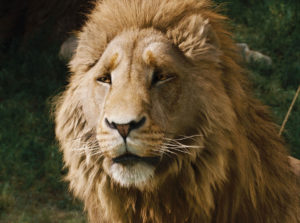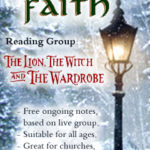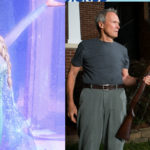Speculative Faith Reading Group 5: Enter The Lion
 Ever wish someone made a method for specific, temporary amnesia? That was my thought when C.S. Lewis, introducing Aslan, said “none of the children knew who Aslan was any more than you do,” but of course I did — and wish I could read this again for the first time.
Ever wish someone made a method for specific, temporary amnesia? That was my thought when C.S. Lewis, introducing Aslan, said “none of the children knew who Aslan was any more than you do,” but of course I did — and wish I could read this again for the first time.
Re-reading chapter 7 again with my wife, I also realized this obvious truth: at some time, in the past, there was only one Chronicle of Narnia. Imagine that. For us, the stories are simply there. They’ve grown in place, like a volunteer maple tree whose origin we missed. And in the years since the Chronicles have seeded countless other fantasy stories.
Moreover, Lewis’s classics have contributed to many readers’ understandings of Aslan — the supposal, as Lewis said, of how Christ would work in a world like Narnia, if it were real.
Chapter 7: A Day with the Beavers
- Ever notice how some chapter titles give away what happens in the material? Thinking about it, would you (if you were younger) be grateful for this “spoiler,” or disappointed?
- Lewis describes how each of the children felt upon first hearing the name “Aslan” (page 67). What is your reaction to their reactions? What does each reaction show about the character — beyond perhaps the clearest example of Edmund’s “mysterious horror”?
- It’s difficult to explain this kind of reaction, Lewis says, yet he gives an example from the world of dreaming. Does that help you imagine it better?
- Notice how Lewis takes us inside each of the children’s minds. How is that similar to other books in which the author is “omniscient”? How is it unlike other stories in which the author is only limited to one person’s thoughts or perspectives at a time?
- Lewis spends a lot of time describing the land through which the children walk, the frozen river, the Beavers’ house, and especially the dinner they prepare. Why so much time? Do you feel like you want to move on past parts like this and get to more of the plot itself? Or do you like “relaxing,” in a way, and imagining the world and its food?
Chapter 8: What Happened After Dinner
- For the second time, we hear that the Witch can turn creatures and people into stone. Why do you believe this is the Witch’s power? Why not turn them into snow or ice, or simply kill them? What do you think it would be like to be turned into stone? While it’s not a pleasant thought, how does picturing that nastiness “raise the stakes” of the story?
- Why do the children want so badly to hear about who Aslan is (page 78)?
- Why does Mr. Beaver assume the children would already know about Aslan?
- Here’s a vital question for this series: who is Aslan? Is he the same as Jesus Christ? Is he an “allegory” for Jesus Christ? Or is Aslan something else entirely? Who would we ask?
- I have read the opinions of people who don’t like the fact that Aslan spends time away from Narnia, and only just now returns after the land suffered 100 years of winter. Do you think they have a point? Is that similar to, or unlike, how Jesus works in our world?
- Mr. Beaver is confident the White Witch can do nothing to stop Aslan. Is he right about Aslan? Is this another way in which Aslan of Narnia is similar to Jesus of our world?
- Mr. Beaver’s line about Aslan (from page 80) is famous: “Who said anything about safe? ‘Course he isn’t safe. But he’s good. He’s the King, I tell you.” Later we learn that it’s said Aslan is “not a tame lion.” Is this true, or false, or a mixture? How might we know?
- Some don’t like the idea of Aslan being unsafe. They’d prefer him being a “tame lion” who stays near to help with their problems. Is that a right view? Do you feel that way?
- After all this great theology, we run into something very strange (on page 81). Mr. Beaver says the White Witch “comes of your father Adam’s … first wife, her they called Lilith.” What in the world does this come from? (Answer: Jewish mysticism about Adam having a wife before Eve, called Lilith.) Why doesn’t the author say this is incorrect?
- Or is it incorrect? We now know the White Witch comes from a land called Charn, but that doesn’t mean the “Lilith” lineage notion is untrue. How do you interpret this?
http://wedgwoodcircle.com/news/articles/sometimes-fairy-stories-may-say-best-whats-to-be-said/












































C.S. Lewis himself answered number four of the second section.
“”I did not say to myself ‘Let us represent Jesus as He really is in our world by a Lion in Narnia’; I said ‘Let us suppose that there were a land like Narnia and that the Son of God, as he became a Man in our world, became a Lion there, and then imagine what would happen’”.”
It may not be as theological “safe,” but it forces us to think about God’s character, not just his actions (which show his character, but then,,,,)
By the time I knew who Lilith was, I guess I sort of assumed it was a kind of “mythological lineage” like how Caesar and Augustus claimed to belong to the lineage of Julus, or Ascanius, who was Aeneas’ son.
But I guess in a way it’s true, even if she’s not really related, because she seems to act a lot like Lilith, grasping at power and corruption and such. She’s sure a spiritual inheritor of Lilith.
What Galadriel said. Seriously, I was planning to say the same thing, though I didn’t have the quote handy. We think of Aslan as an allegorical representation of Jesus, but he’s much more a type instead. There just aren’t enough one-on-one correlations.
For example, Jesus didn’t die on a stone table. Certainly it represented an altar, and there’s great power in the image. In many ways it accomplished much more than allegory could have.
Becky
Hi Stephen
Unfortunately I can’t contribute to this discussion as often as I’d like because Ican’t see around 90% of the comments in my browser. I discovered at work that they are completely visible in Firefox but unfortunately work protocol means I can’t spend time on websites like this! So this answer may already be given and I apologise.
In the legends of northern Europe, there are spirits called the ‘dark mothers’. Goethe refers to them. The Icelandic sagas mention them. In Norse they are the disir. The singular of disir is dis, as in Jadis. The original ‘dark mother’ (in one sense) is Lilith.
Whether you take Lewis’ remark as simply a literary reference to these malign spirits or whether they actually exist (as some Christians I know involved in spiritual warfare believe) is up to you. I consider that certain late remarks by Lewis about his early poetry indicate he himself was of the latter opinion.
Anne, I’d rather not handle tech support here, so if would message me on Facebook with more information about the comment issues (particularly your operating system and browser), I can try to address those from a web-design perspective. As a web designer, there always seems to be one kind of software that doesn’t comply, or with which the site layout doesn’t comply.
Somehow I neglected to include this link (in the text Who would we ask?) as had been included in this column’s original version. Here it is:
He especially comments on how Aslan revolutionized and organized his images.
From Becky:
I’m still trying to straighten out the differences between allegory, type, and supposal. In this case I am having a hard time separating “type” from how the Apostle Paul used it to describe the rock in the desert (1 Cor. 10). That seems to connote an advance symbol of Christ, that is, one that preceded him. But I’m likely over-narrowing the definition. Anyway, Aslan and Christ are very different in many ways — just as were Jonah, King David, and Elijah, all of which Scripture describes as Christ-figures. (This, by the way, is also how even Harry Potter can be described as a Christ-figure, or at least a Christ-figure-figure, without taking things too far.)
Aslan is still a little different from all those, though. Lewis would have said, in the story-world, that this was Jesus, a “supposal” of how He might truly work in such a world. In fact, Lewis all but said Aslan “turns into” Christ at the series’ very end.
Yes. The story was set free to explore more, while not calling Christ’s reputation or His work in the real world into question. There are other differences between Aslan’s death and Christ’s, however (e.g., the White Witch gives the only wrath we see). I believe these actually strengthen the story — while reminding us that the flawed “Narnia is okay because it’s only allegory” approach is fraught with issues!
My thought about the “Lilith” line is that Lewis threw that out there as a more-overt mythological tie-in than the more-subtle references and inclusions he seemed to prefer later. One could say this is still Narnian “canon.” After all, we don’t know the whole backstory of the Witch’s home world of Charn, which could have been founded from Lilith’s evil line. But I would overthrow that concept by suggesting this: Charn started out as a good world, we’re told in The Magician’s Nephew, and gradually went bad in ways we can only imagine.
Moreover, while there are all kinds of mysteries in how people get from Narnia to our world and vice-versa (one thing that makes the series so great), we’re not told of any “mechanism” that would allow a mythological line of “Adam’s first wife, Lilith,” to found a Charn empire in a completely alternate plane of existence.
I believe Mr. Beaver was simply wrong — or, more likely, it’s simply an intra-series contradiction. When Lewis came to writing the prequel, he didn’t try to reconcile the two (as he did with other things).
I don’t think children naturally worry about spoilers. They just want to know what happens.
We all react to God differently, because we are all different images of God’s nature — that’s a principle that seems prominent in Lewis’s non-fiction. I think the three children’s feelings on hearing of Aslan express the essence of who they are.
I remember marvelling at how quickly the POV changed from Lucy to Edmund in one of the earlier chapters, but I’m sure my surprise was only due to being used to modern style. Here, Lewis is using omniscient POV with great skill; he’s showing the feelings of each child. It would have been impossible to show this following all the rules of modern limited POV. Lewis was a great writer whose skill allows him to suggest themes and meanings with omniscient POV while still holding the story together coherently.
The plot really does move by quickly. The diversion is relatively brief, and the portrayal of life in Narnia makes the Chronicles different from children’s books where the authors wrote down to the supposedly young audience. A sense of the Beavers’ natural surroundings had to be built in order to create the sense of wrongness and urgency about the workings of the Witch. Again, Lewis was a great writer.
Because he’s the “King,” the “Lord of the whole wood,” just as surely as he is the Lion.
Since Lewis said that Aslan is how he supposes Christ might appear in a world like Narnia if such a world existed, one thing to consider is that Narnia is a world of sentient animals and living mythology. In particular, I think the countryof Narnia within the world of Narnia is the special domain of sentient animals.
Lucy asks, “Is he a man?”, and the answer is “…Don’t you know who is the King of the Beasts? Aslan is a lion — the Lion, the great Lion.” (p. 146 of the all-in-one edition). The lion is the King of the Beasts, and the Lion is the Lord of a world of beasts. But of course, the King of the Humans must be a man, the Man, the great Man.
I have read the opinions of people who don’t like the fact that Aslan spends time away from Narnia, and only just now returns after the land suffered 100 years of winter. Do you think they have a point? Is that similar to, or unlike, how Jesus works in our world?
A lot of that might stem from misinterpreting LWW as a pure allegory. If Aslan represents Christ Himself, all that Christ is in a theological sense, then we could come to the conclusion that Lewis is showing Christ to be a neglectful Lord. But Aslan isn’t a direct representation of everything that Christ is.
Mr. Beaver says that Lilith was one of the “Jinn” and that the Witch’s father was not Adam. This reminds me of apocryphal legends and pre-Flood speculation. Or really, it would be pre-Creation speculation, and thus not likely to be considered orthodox. But this is fantasy, and we can pretend that long before the Flood there may have been frequent contact between the new-born Earth and other, older and dark worlds, right?